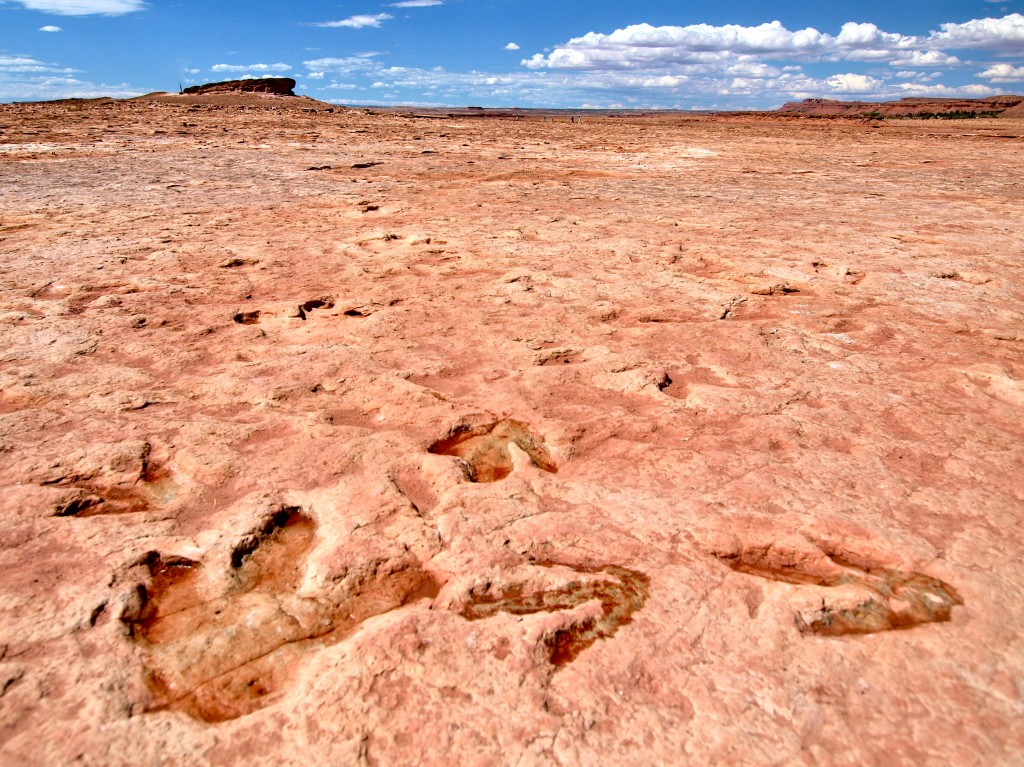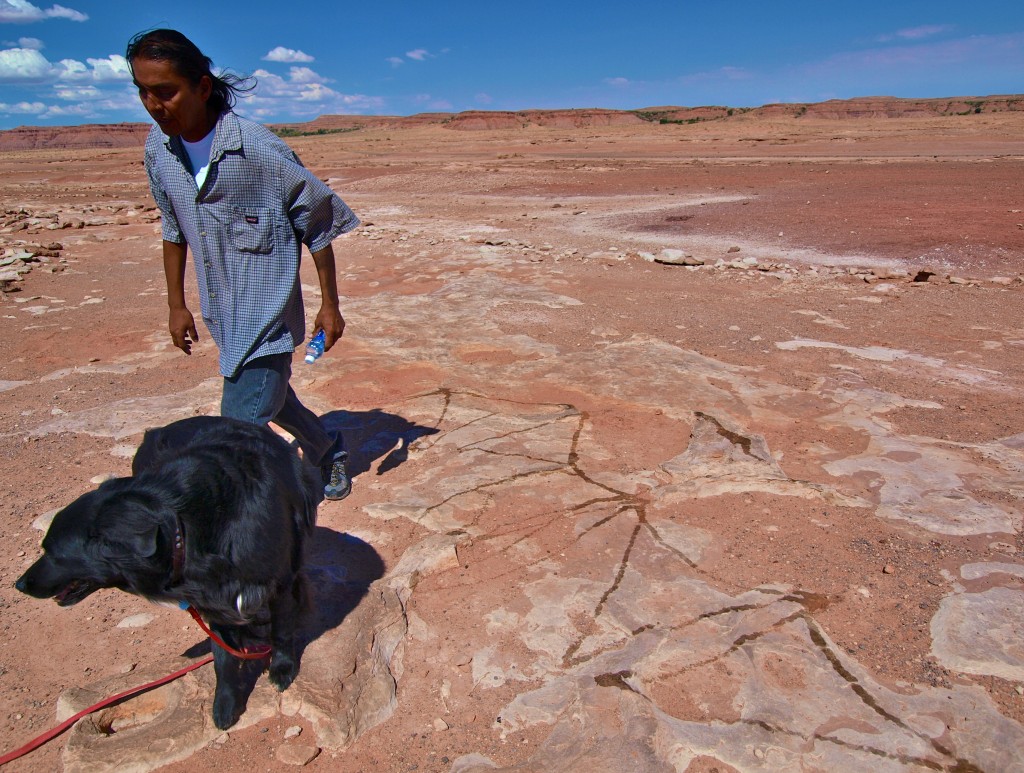A few weeks ago, driving across Navajoland in northeast Arizona, I stopped to see some dinosaur tracks just west of Tuba City. As I pulled into the parking area, on the north side of highway 160, a Navajo man got up from a group sitting in lawn chairs by a hand written “Dino Tracks” sign.
“Hi, my name is Denny,” he said. “Would you like to see the dinosaur tracks?” I said yes and asked if there was a fee and if my dogs could come and he told me he worked for tips, and assured me the dogs were welcome.
The trackway started a short distance from the parking lot: dozens of deep, three toed tracks neatly printed in red sandstone. Dinosaur tracks often look nothing like anything, often just a mud smear solidified in rock. As a lifelong dinosaur buff and an avid traveler in geology, I had visited a lot of tracks all over North America and these were striking, the clearest I’d ever seen, with toes and talons clearly preserved.
Well-preserved tracks are valuable to scientists as they can reveal more than bones, including rare information on dinosaur behavior, locomotion, and anatomy. Groups of different tracks like those at the Tuba City Trackway can also provide clues on Mesozoic ecology, diversity of species, social behavior and geographic distribution.
Around two hundred million years ago, the Tuba City tracks had been left in wet sand along a beach at the edge of an inland sea. In a span of a few hours, something like 20 different dinosaurs from several different species, large and small, full grown and young – all bipedal three-toed carnivores – had walked here, crisscrossing one another’s paths, leaving trackways in all directions. Then the prints were covered over with protective silt that was finer than the sand.
Eons later, erosion stripped away the finer siltstone, exposing the harder sandstone layer with the tracks. In the 1940’s, scientists descended on the trackway. Chipping away at the layers of rock, a team led by paleontologist Sam Welles from the University of California Museum of Paleontology exposed many more tracks and even excavated a large Dilophosaurus skeleton nearby. To this day, the Navajo consider the Welles excavations a form of vandalism and the fossils, whisked away to the museum, stolen property.
As we walked around the trackway, Denny squirted the best impressions with water, so they’d stand out better for my photographs and took me through his spiel. “See this group here? This was a family, father, mother and baby,” he said, circling a group of large, medium and tiny three-toed tracks with a stream from his water bottle. He pointed out a T-Rex track and outlined a fully articulated pterodactyl, lying wings outstretched.
All malarkey. For one thing, Tyrannosaurus rex lived in the Cretaceous, more than 130 million years after the trackway was laid down. The “pterodactyl”, more properly known as a pterosaur, was just a uniquely weathered chunk of sandstone. And I was pretty sure the eggs and coprolites he pointed out were just iron concretions.
But I didn’t mind Denny’s misinformed science. I already knew that version of the story. I was more interested in the Navajo version. How did Denny’s ancestors explain these tracks, long before scientists came along to tell them otherwise? When Denny pointed to a green oasis against some cliffs, about a mile away across the barren red rock desert and said, “That’s Moenave. Where I grew up,” I asked him. “What’s the Navajo story about these tracks?”
He smiled and told me the traditional Navajo name for this place was Naasho’illbahitsho Biikee or “Place of the Big Lizard Tracks”. Here, long ago, on the edge of an ancient sea, fearsome monsters had waged a great battle against the “Twin Heroes”.
The Twin Heroes play major roles in the Navajo creation story, Diné Bahane’. Before the creation of the Earth, spirits lived in a succession of three underworlds before emerging into the Fourth World, known as Niʼ Hodisxǫs, where they created man.
The Fourth World was no Eden. Monsters ruled the land, including terrible lizards. The first human born in the Fourth World, Asdzaa Nadleehe gave birth to twin boys, Naayééʼ Neizghání and Tóbájíshchíní, who grew up to be the Twin Heroes.
Battles between the Twins and the monsters took place all over the Navajo World; and each time the Twins prevailed, they buried the beasts in the ground and turned them to stone. Eventually, the Twins rid the world of monsters and people inherited the Earth.
“Scientists should come see and study these tracks,” Denny said. “But we believe that digging up the monsters is disrespectful to the Twins.” Looking across the desert to Denny’s oasis, where his ancestors have lived for much longer than scientists have known about dinosaurs, I had to agree. On Navajoland, we should let the monsters lie.
_____________
Mary Caperton Morton is a freelance writer and photographer currently based in Cerrillos, New Mexico. Follow her travels at www.theblondecoyote.com.
The beautifully clickable photos are, as always, her own. Be sure to note the “pterodactyl” in the bottom photo. Green Moenave is visible in the distance, over Denny’s left shoulder.


I’ve had the same thought or wonder about the Native Americans and the remains of the dinosaurs…and there would be stories or myths for all. Another well-told travel story, Mary. Thank you.